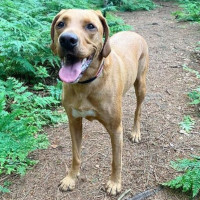Appearance of the Labrala
|
| The Labrala seems to have inherited the best features of each parent. They are incredibly handsome and carry themselves with great aplomb. Their heads are relatively large, with distinctly drooping upper lips and black and amber-brown eyes. Their ears hang to the side of their faces, and are quite large in some individuals. Their rectangular bodies are built of solid muscle and supported by straight limbs. Their tail is of medium length and normally quite thin. While many of the breed's dogs retain the rusty-red color of the Hungarian Shorthaired Pointer, others have black, cream or dark brown coats. Their coat is short and straight, fitting closely to their body. A large dog breed, a fully grown Labrala will reach weights ranging from 22 to 36 kg and heights from 53 to 63.5 cm. Unlike their Labrador relatives, they tend to be able to maintain a lean body condition and are less prone to obesity. |
Temperament of the Labrala
|
| As you'd expect from this breed, the Labrala is a clever dog with good people skills. As well as being a friend to humans of all ages, they get on well with other dogs. They love company and are never happier than when they're next to their owner. In fact, these dogs can sometimes become overly devoted, with over-dependence and separation anxiety a problem for some. Full of energy, sometimes to the point of hyperactivity, Labrala are not the type to lounge on the sofa watching the world go by. They love being out in nature, and are in their element when they're running through fields and swimming in rivers. With a natural protective streak and unrivalled loyalty to their owners, most Labralas are good watchdogs. However, they should not be used as defense dogs, as they lack the necessary hostility. |
Needs and activities of the Labrala
|
| Labralas need plenty of exercise, and you should plan on around one hour to 90 minutes of vigorous activity per day. Some of the activities Labralas can enjoy are at the dog park, lively neighborhood walks, chasing squirrels and birds in the yard, playing fetch or Frisbee, agility training, swimming and hiking. They also love to hunt, so if that's something you enjoy, your Labralas would be a good partner. If Labralas don't get enough exercise every day, they tend to become anxious or aggressive. They can also develop bad habits, such as chewing on objects, destroying property or barking excessively. |
Maintenance of the Labrala
|
| You should brush your Labralas at least two or three times a week with a brush or rubber brush. Their coats are short and they are very clean dogs, so they rarely need bathing. When shampooing, it's best to ask your vet what type of shampoo to use. In addition, they need to have their ears cleaned about once a week, and you need to be alert to redness and irritation, as they are prone to ear infections. You should also brush his teeth once or twice a week and trim his nails as required, usually once every six to eight weeks. |









 English (United Kingdom)
English (United Kingdom)